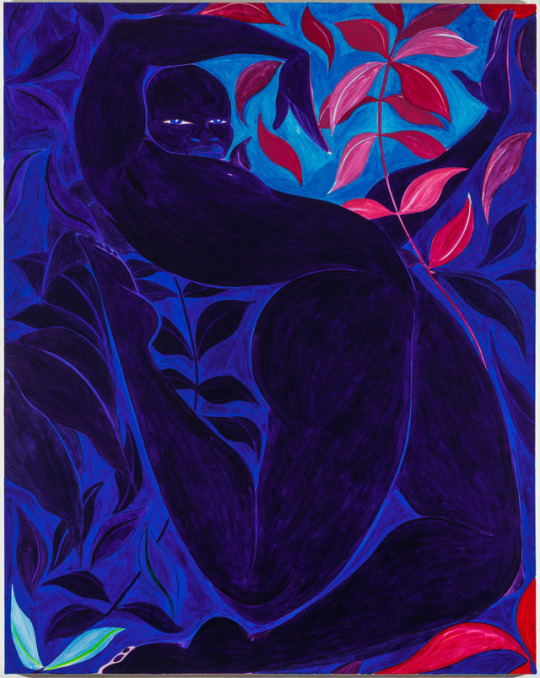Art, culture, galleries, events & musings on the contemporary African art scene.
Don't wanna be here? Send us removal request.
Photo

Alex Jackson
A Son Never Forgets (Love Your Flesh)
2017. Oil on canvas
0 notes
Video
youtube
Wafrica creator Serge Mouangue discusses his artistic vision for Wafrica / Le kimono Africain
0 notes
Photo
This cross-cultural dialogue is so perfectly executed! And the patterns blend the craftsmanship DNA of both cultures.

‘Wafrica’ kimono by Cameroonian designer Serge Mouangue and traditional Japanese kimono maker Odasho.
9K notes
·
View notes
Photo

Wafrica kimono designed by Cameroon-born, Tokyo-based designer Serge Mouangue
35 notes
·
View notes
Photo

Ngady a Mwaash royal mask of the Kuba people, Democratic Republic of the Congo (Zaire). Artist unknown; between 1890 and 1910. Now in the Peabody Museum, Harvard University.
96 notes
·
View notes
Photo




EL ANATSUI
Many Come Back, 2005
Aluminum and copper wire 213.3 x 292.1 cm
Regal & mesmerizing. Devil’s in the details. If you see his work in person, get a close up (camera or as close as you can) and really take a look at the craftsmanship that goes into every tiny detail. Even more entrancing than the overall design.
At the Gardner Museum Common Threads exhibit.
1 note
·
View note
Photo

Tunji Adeniyi Jones Blue Dancer oil on canvas 2017
128 notes
·
View notes
Photo

Guggenheim Art After Dark
I still haven’t been to an after dark event. What’s the museum like in the wee hours?
0 notes
Photo



Joana Choumali. Haabre Photo Collection
These rich, intense portraits capture that fleeting slice of emotion from each of her subjects. Check it out to learn more about the cultural backdrop interwoven into the series.
0 notes
Photo

Modupeola Fadugba
346 notes
·
View notes
Photo
The fact that these are PENCIL DRAWINGS will never cease to amaze me!






Nigerian artist Arinze Stanley
235 notes
·
View notes
Text
Why are there no African Louis Vuittons?
The continent has a rich history of artisan craftsman ship.
Bronze sculpture, basket weaving, fabric weaving, mud print and traditional dyeing methods to name a few. But despite the proliferation of these common imageries and motifs, there are no old design houses that have known, signature design styles. No royalties, no legacies, no official international presence that can herald with its simple design, the legacy of these artisans’ works.
Why?
Sometimes I wonder if this culture of community has prevented Africans from viewing their work as their own, owned by an individual or even an immediate family for stamping and cordoning off from the wider group. Coupling that with the economic realities of many of these regions and I find that there is no real incentive to differentiate, offer quality and ‘market’ their own differences for the individuals’ benefit.
But in today’s wider economy, shouldn’t that be easier to do?
I see a few barriers to entry.
The cultural barriers
Outside In: When villager communities and small time entrepreneurs are tapped for their talents in the name of social entrepreneurship projects, they rarely are anywhere near the helm of the enterprise.
We’ve all seen the ubiquitous photos of happy, grateful villagers (almost always women), who ferret away producing handicrafts to be used as McAfrica**™ **representations for well-meaning yuppies the world over. But they remain faceless brand ambassadors of these social enterprise movements. On a continent with such a strong history of women in enterprise, I’d like to see more of these women (and men) given the space and true backing to launch their own brands and tell their own stories, processes, and visions.
Inside Out: We Africans share a common identity with the idea of “we”. Family, community, collective. People create because their forefathers created, season their stew, sell in local markets, pursuing work, success and opportunities in the name of supporting their children, parents, families. We work to move each other along. But in doing so, do we lose the push that the Western value of the individual offers?
The economic barriers
Many of these Next 11 economies rely on International interest, resources and talent in partnership for their growth. But the base of the pyramid incentives are lacking. With the various financial models that have come, evolved and gone on the continent, few entrepreneurs have the backing or local push to really move beyond their immediate purview to garner a wider audience for their work. Moreover, where day to day survival is not guaranteed, are there really opportunities to take real risks, or to spend more time on pieces?
0 notes
Photo
I love how sensual these lines are and the sumptuous flow of colour. Quickly becoming one of my favourite artists.

Tunji Adeniyi-Jones
Blue Dancer, 2017
Oil on canvas, 68 x 54 inches
7K notes
·
View notes
Photo

Delphine Diallo
The intricacy is unreal.
0 notes
Photo

Cyrus Kabiru, Kwa Kubadilishana Utamaduni, Macho Nne: At the Dot, 2017.
Photographic Print. 59 1/10 × 47 1/5 in (150 × 120 cm)
2K notes
·
View notes



